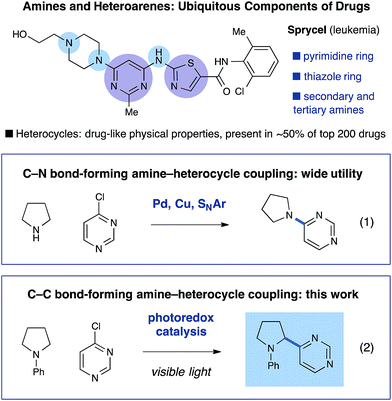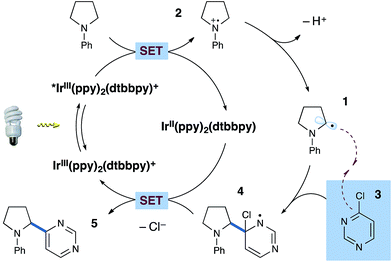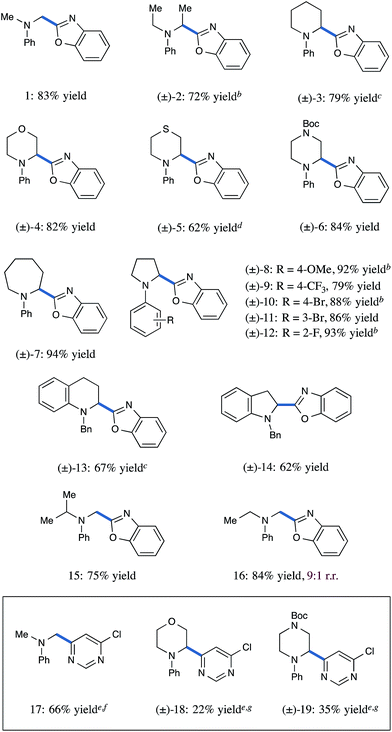Amine α-heteroarylation via photoredox catalysis: a homolytic aromatic substitution pathway†
Christopher K.
Prier
and
David W. C.
MacMillan
*
Merck Center for Catalysis at Princeton University, Princeton, New Jersey 08544, USA. E-mail: dmacmill@princeton.edu; Fax: +1 609 2585922; Tel: +1 609 2582254
First published on 4th August 2014
Abstract
The direct α-heteroarylation of tertiary amines has been accomplished via photoredox catalysis to generate valuable benzylic amine pharmacophores. A variety of five- and six-membered chloroheteroarenes are shown to function as viable coupling partners for the α-arylation of a diverse range of cyclic and acyclic amines. Evidence is provided for a homolytic aromatic substitution mechanism, in which a catalytically-generated α-amino radical undergoes direct addition to an electrophilic chloroarene.
Introduction
Heterocycles and heteroaromatics are ubiquitous components of biological systems and pharmaceutical research. These invaluable structural motifs are broadly employed in the development of medicinal agents due to their capacity to (i) drive therapeutic potency, (ii) lower drug lipophilicity, (iii) increase aqueous solubility, and (iv) reduce the inhibition of cytochrome P450s.1 Indeed, at the present time heteroaromatics feature in approximately half of the top 200 pharmaceuticals sold worldwide.2 It is not surprising therefore that coupling reactions which generically connect heterocyclic moieties to other molecular fragments are now mainstay transformations in medicinal agent synthesis. For example, couplings between heterocycles and amines via C–N bond-forming reactions, either via nucleophilic aromatic substitution (SNAr)3 or transition metal-catalyzed approaches,4 have been extensively studied and applied (Fig. 1, eqn (1)).5 In contrast, fragment coupling methods that unite heteroaromatic units with the amine α-carbon position (Fig. 1, eqn (2)) are relatively unknown, despite the opportunity to access medicinal agents with similar physiological properties and with proven clinical utility (e.g. Veliparib,6 Pradaxa,7 and Benthiavalicarb8). While important strategies for amine α-arylation have been reported by Dieter,9 Campos,10 Nakamura,11 and others,12 a generic yet mild α-arylation protocol remains largely elusive.Visible light photoredox catalysis has emerged in recent years as a powerful platform for the development of new reactions in organic synthesis.13 In this context, we have recently demonstrated that photoredox catalysis can be employed to mediate the α-arylation of amines using electron-deficient benzonitrile coupling partners.14 In this protocol, activation of the amine α-C–H bond is achieved via single-electron oxidation followed by α-deprotonation to generate the critical α-amino radical 1 (Scheme 1).15 Concomitant single-electron reduction of an accompanying benzonitrile provides a stabilized radical anion, which undergoes selective hetero radical–radical coupling with the neutral radical species 1 to forge the desired α-amino arylation products. Taking inspiration from the Minisci reaction,16 we recently questioned whether a photoredox-based amine α-arylation could be achieved by the addition of an α-amino radical 1 to a ground-state, neutral arene via a homolytic aromatic substitution pathway.17–19 This approach would constitute an alternative catalytic mechanism that would obviate the need for cyanoarenes and the accompanying radical anion pathway. Herein, we report the successful execution of this plan and describe a new coupling mechanism that employs chloroheteroarenes for the direct α-arylation of amines.
Design plan
As shown in Scheme 1, our proposed mechanism called for a sufficiently oxidizing photocatalyst, e.g. iridium complex Ir(ppy)2(dtbbpy)PF6 (ppy = 2-phenylpyridine, dtbbpy = 4,4′-di-tert-butyl-2,2′-bipyridine, E*III/II1/2 = +0.66 V vs. SCE)20 to oxidize the amine substrate via a single electron transfer (SET) mechanism (Ered1/2 = +0.71 V vs. SCE for N,N-dimethylaniline).21 This electron transfer step would lead to a reduced iridium complex IrII(ppy)2(dtbbpy) with concomitant formation of the amine radical cation 2, a species that may be deprotonated at the α-C–H position to generate the α-amino radical 1.22 Addition of this neutral radical species 1 to a highly electrophilic heteroarene 3via homolytic aromatic substitution was expected to provide the radical σ-complex 4, which may readily undergo single-electron reduction (Ered1/2 = −0.26 V vs. SCE for the hydroxycyclohexadienyl radical)23,24 followed by loss of an anionic leaving group (Cl−) to provide the α-heteroaryl amine product 5. This reduction step would simultaneously complete the photoredox cycle (Ir(II) to Ir(III)) via reconstitution of the Ir(ppy)2(dtbbpy)PF6 catalyst. Importantly, the incorporation of an anionic leaving group in the arene coupling partner would render this process redox neutral, obviating the need to employ either stoichiometric oxidants or reductants, while only generating HX as a reaction byproduct. Moreover, we anticipated that this strategy would enable the coupling of a diverse array of heteroaromatic rings while exhibiting complementary scope to our previously reported cyanoarene radical anion pathway.Results and discussion
We initiated our α-amino arylation investigation by examining the utility of various 2-halo-benzothiazoles given their utility as potent electrophiles in two-electron SNAr chemistry. While attempts to employ the cyano-substituted benzothiazole met with little success, we were delighted to find that bromo- and chloro-leaving groups provided the product of α-heteroarylation in useful yields using tris(2-phenylpyridinato-C2,N)iridium(III)[fac-Ir(ppy)3] as the photocatalyst (Table 1, entries 3 and 4, 50 and 56% yield). Next, evaluation of a variety of visible light photocatalysts revealed higher efficiencies could be obtained with the heteroleptic iridium complex Ir(ppy)2(dtbbpy)PF6 in the presence of 2-chlorobenzothiazole (entry 6, 75% yield). Moreover, lowering the photocatalyst and amine loadings did not lead to diminished reaction yields (entries 7 and 8). Intriguingly, the addition of water was found to improve the overall efficiency of this arylation protocol, with ten equivalents providing optimal yields (entry 10, 87% yield).25 Finally, while a low yield of product was obtained upon visible light irradiation in the absence of photocatalyst (entry 11),26 no reaction was observed in the absence of either light or base (entries 12 and 13).With respect to the scope of the arene component in this coupling reaction, we have found that a range of five-membered heteroaryl chlorides function as suitable substrates (Table 2). For example, a variety of benzoxazole, benzothiazole, and benzimidazole-derived scaffolds may be installed in high yields (entries 1–5 and 7, 87–93% yield). Moreover, monocyclic imidazole and thiazole substrates are well-tolerated (entries 6, 9, and 11, 77–82% yield). The nature of the 6,5-heteroaromatic may also be broadly varied, as exemplified by the installation of the imidazopyridine and caffeine ring systems (entries 8 and 10, 94 and 81% yield). Furthermore, five-membered heteroaromatic rings that incorporate three heteroatoms may be utilized, as highlighted by the coupling of a 1,3,4-thiadiazole (entry 12, 65% yield). Importantly, heteroaromatic substrates that include a second halide substituent (F, Cl, Br) at a non-electrophilic site remain viable in this protocol (entries 4, 5, and 9), an important consideration with respect to (i) predictable regiocontrol of the arylation coupling site and (ii) the compatibility of this protocol with complementary coupling technologies in a synthetic sequence.
| Entry | Leaving group (X) | Amine (equiv.) | Photocatalyst (mol%) | Yielda (%) |
|---|---|---|---|---|
| a Yield after 24 h determined by 1H NMR analysis of crude reaction mixture with internal standard. Reactions performed with 2 equiv. NaOAc and 0.25 M DMA. b With 3 equiv. H2O. c With 10 equiv. H2O, isolated yield. d Performed in the absence of light. e Performed in the absence of NaOAc. | ||||
| 1 | CN | 3 | Ir(ppy)3 (1 mol%) | 4% |
| 2 | I | 3 | Ir(ppy)3 (1 mol%) | 5% |
| 3 | Br | 3 | Ir(ppy)3 (1 mol%) | 50% |
| 4 | Cl | 3 | Ir(ppy)3 (1 mol%) | 56% |
| 5 | F | 3 | Ir(ppy)3 (1 mol%) | 16% |
| 6 | Cl | 3 | Ir(ppy)2(dtbbpy)PF6 (1 mol%) | 75% |
| 7 | Cl | 3 | Ir(ppy)2(dtbbpy)PF6 (0.5 mol%) | 78% |
| 8 | Cl | 1.5 | Ir(ppy)2(dtbbpy)PF6 (0.5 mol%) | 77% |
| 9b | Cl | 1.5 | Ir(ppy)2(dtbbpy)PF6 (0.5 mol%) | 84% |
| 10c | Cl | 1.5 | Ir(ppy)2(dtbbpy)PF6 (0.5 mol%) | 87% |
| 11 | Cl | 1.5 | None | 11% |
| 12d | Cl | 1.5 | Ir(ppy)2(dtbbpy)PF6 (0.5 mol%) | 0% |
| 13e | Cl | 1.5 | Ir(ppy)2(dtbbpy)PF6 (0.5 mol%) | 0% |
a Conditions as in Table 1, entry 10 unless noted.
b Chloroarene starting material and product are a 1![[thin space (1/6-em)]](https://www.rsc.org/images/entities/char_2009.gif) : :![[thin space (1/6-em)]](https://www.rsc.org/images/entities/char_2009.gif) 1 mixture of regioisomers with respect to position of the Boc group.
c Performed using 3.0 equiv. arene to 1.0 equiv. amine and 30 equiv. H2O.
d Performed at 0 °C.
e Performed using 1.5 equiv. arene to 1.0 equiv. amine.
f Performed with 40 equiv. H2O.
g Performed without H2O. 1 mixture of regioisomers with respect to position of the Boc group.
c Performed using 3.0 equiv. arene to 1.0 equiv. amine and 30 equiv. H2O.
d Performed at 0 °C.
e Performed using 1.5 equiv. arene to 1.0 equiv. amine.
f Performed with 40 equiv. H2O.
g Performed without H2O.
|
|---|
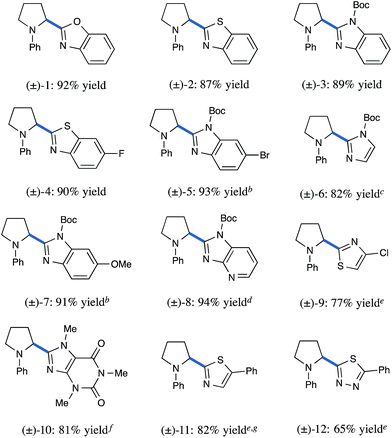
|
Having successfully demonstrated α-heteroarylation with a variety of five-membered heteroarenes, we next anticipated that electrophilic six-membered heterocycles might also engage in this new α-amino coupling protocol (Table 3). In general, pyrimidine substrates were found to be viable, with a second electron-withdrawing substituent typically providing superior yields. Thus, 2-chloropyrimidines bearing ester, amide, or trifluoromethyl functionality at the 5-position undergo coupling with excellent efficiency (entries 1–3, 73–84% yield).27 Pyrimidines that incorporate a second aromatic ring (entry 4, 73% yield) or a halide substituent (entry 5, 74% yield) may also be successfully employed. Performing these reactions at sub-ambient temperatures (0 °C) with added water is critical for suppressing arene decomposition and achieving high levels of reaction efficiency (see ESI†). Pyrimidines bearing a chloride leaving group at the 4-position also undergo coupling (entries 6–8, 72–92% yield), and ortho-substitution on the pyrimidine ring is tolerated, albeit with diminished yield (entry 9, 64% yield). Again, the compatibility of a second chloride substituent on the pyrimidine substrate allows for subsequent product functionalization via a range of transformations. Finally, this photoredox protocol may be used to install a variety of other 6-membered heteroarenes including purines (entry 10, 73% yield) and 1,3,5-triazines (entries 11 and 12, 88 and 84% yield).
| a Conditions employ 25 equiv. H2O at 0 °C, unless otherwise noted. b Performed using 5 equiv. H2O, 1.0 equiv. amine, and 1.5 equiv. arene. c Performed at 10 °C. d Performed using 40 equiv. H2O, 1.0 equiv. amine, and 3.0 equiv. arene; product obtained as a single regioisomer. e Performed using 1.0 equiv. amine and 1.5 equiv. arene. f Performed using 50 equiv. H2O. |
|---|
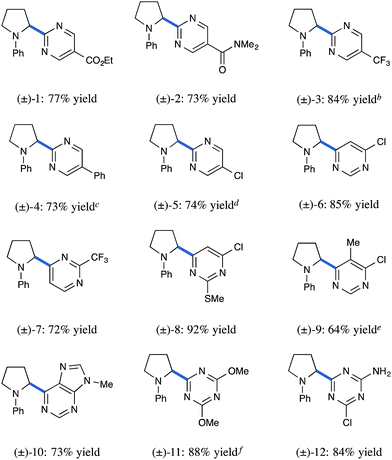
|
With regard to the scope of the amine coupling partner, we anticipated that a range of readily oxidized tertiary anilines would serve as competent substrates. Indeed, using 2-chlorobenzoxazole as a representative heteroarene, we were pleased to find that both acyclic (Table 4, entries 1 and 2, 83 and 72% yield) and cyclic dialkylanilines (entries 3 and 7, 79 and 94% yield) undergo α-arylation with excellent efficiency. Moreover, saturated heterocyclic ring systems such as morpholine, thiomorpholine, and piperazine were found to be amenable to this photoredox heteroarylation (entries 4–6, 62–84% yield). Electron-donating as well as withdrawing substituents on the N-aryl ring are tolerated, and may be incorporated at the para, meta, or ortho positions (entries 8–12, 79–93% yield). Medicinally relevant tetrahydroquinoline and indoline architectures can also be successfully employed, with arylation proceeding regioselectively at the α-amino ring position in lieu of the exocyclic benzylic site (entries 13 and 14, 67 and 62% yield). Unsymmetrical, acyclic dialkylanilines interestingly undergo functionalization at methyl α-substituents in preference to methine (entry 15, single regioisomer) and methylene (entry 16, 9![[thin space (1/6-em)]](https://www.rsc.org/images/entities/char_2009.gif) :
:![[thin space (1/6-em)]](https://www.rsc.org/images/entities/char_2009.gif) 1 r.r.) α-positions.28 Finally, we provide examples of heteroaryl chloride–amine combinations that undergo coupling with moderate levels of reaction efficiency. As shown, the use of N,N-dimethylaniline, N-phenylmorpholine, and N-phenylpiperazine with 4,6-dichloropyrimidine resulted in diminished yields (entries 17–19, 22–66% yield). While these transformations remain of value to medicinal chemists, we are focused upon overcoming these limitations in efficiency.29 To demonstrate the scalability of the arylation reaction, we additionally performed the coupling of 2-chlorobenzoxazole and tert-butyl-4-phenylpiperazine-1-carboxylate on a 4.0 mmol scale, providing the α-arylated product in 80% yield (1.22 g product, cf.Table 4, entry 6, 84% yield).
1 r.r.) α-positions.28 Finally, we provide examples of heteroaryl chloride–amine combinations that undergo coupling with moderate levels of reaction efficiency. As shown, the use of N,N-dimethylaniline, N-phenylmorpholine, and N-phenylpiperazine with 4,6-dichloropyrimidine resulted in diminished yields (entries 17–19, 22–66% yield). While these transformations remain of value to medicinal chemists, we are focused upon overcoming these limitations in efficiency.29 To demonstrate the scalability of the arylation reaction, we additionally performed the coupling of 2-chlorobenzoxazole and tert-butyl-4-phenylpiperazine-1-carboxylate on a 4.0 mmol scale, providing the α-arylated product in 80% yield (1.22 g product, cf.Table 4, entry 6, 84% yield).
Mechanism
We have sought to obtain evidence for the proposed homolytic aromatic substitution mechanism as outlined in Scheme 1. Stern–Volmer fluorescence quenching studies using the preferred Ir(ppy)2(dtbbpy)PF6 photocatalyst revealed significant emission quenching by N-phenylpyrrolidine, yet no change in the emission was observed using a variety of chloroheteroarene substrates. This finding indicates that a reductive quenching cycle is operative (wherein the excited state of the catalyst first performs amine oxidation). To determine if the neutral α-amino radical 1 undergoes addition to the ground state heteroarene 3 (as proposed in Scheme 1) or if the chloroarene undergoes reduction via electron transfer with the transient IrII(ppy)2(dtbbpy) species (as observed in our cyanoarene studies),14 the reduction potentials of several chloroheteroarene substrates were measured by cyclic voltammetry. These potentials were found to range from −1.70 V to −2.19 V vs. SCE (see ESI†). More specifically, 2-chlorobenzoxazole was found to undergo reduction at −2.19 V vs. SCE, indicating that electron transfer from the IrII(ppy)2(dtbbpy) species is highly endothermic and suggesting that a radical anion–neutral radical coupling mechanism is not operative.30,31Conclusions
In conclusion, we have leveraged photoredox catalysis to achieve the α-heteroarylation of tertiary amines with a diverse array of five- and six-membered heterocycles via a putative homolytic aromatic substitution pathway. Given the prevalence of heterocycles in medicinal agents, as well as the commercial availability of a large number of chloroheteroarenes, we expect that this reaction will find immediate application in the synthesis of biologically active compounds.Acknowledgements
Financial support was provided by the NIHGMS (R01 01 GM093213-01), Merck and Amgen. C. K. P. is grateful for a Bristol-Myers Squibb graduate fellowship. We thank Yuan Hu for generous assistance with cyclic voltammetry.Notes and references
- T. J. Ritchie, S. J. F. Macdonald, S. Peace, S. D. Pickett and C. N. Luscombe, MedChemComm, 2012, 3, 1062 RSC.
- N. A. McGrath, M. Brichacek and J. T. Njardarson, J. Chem. Educ., 2010, 87, 1348 CrossRef CAS.
- (a) M. B. Smith and J. March, Advanced Organic Chemistry, Wiley-Interscience, New York, 5th edn, 2001, p. 850 Search PubMed; (b) J. A. Joule and K. Mills, Heterocyclic Chemistry, Wiley, Chichester, 5th edn, 2010 Search PubMed; (c) J. F. Bunnet and R. E. Zahler, Chem. Rev., 1951, 49, 273 CrossRef; (d) J. F. Bunnett, J. Chem. Educ., 1974, 51, 312 CrossRef CAS; (e) K. Walsh, H. F. Sneddon and C. J. Moody, ChemSusChem, 2013, 6, 1455 CrossRef CAS PubMed.
- (a) J. P. Wolfe, S. Wagaw, J.-F. Marcoux and S. L. Buchwald, Acc. Chem. Res., 1998, 31, 805 CrossRef CAS; (b) D. S. Surry and S. L. Buchwald, Chem. Sci., 2011, 2, 27 RSC; (c) J. F. Hartwig, Angew. Chem., Int. Ed., 1998, 37, 2046 CrossRef CAS; (d) G. Evano, N. Blanchard and M. Toumi, Chem. Rev., 2008, 108, 3054 CrossRef CAS PubMed.
- (a) S. D. Roughley and A. M. Jordan, J. Med. Chem., 2011, 54, 3451 CrossRef CAS PubMed; (b) J. S. Carey, D. Laffan, C. Thomson and M. T. Williams, Org. Biomol. Chem., 2006, 4, 2337 RSC.
- C. K. Donawho, Y. Luo, Y. Luo, T. D. Penning, J. L. Bauch, J. J. Bouska, V. D. Bontcheva-Diaz, B. F. Cox, T. L. DeWeese, L. E. Dillehay, D. C. Ferguson, N. S. Ghoreishi-Haack, D. R. Grimm, R. Guan, E. K. Han, R. R. Holley-Shanks, B. Hristov, K. B. Idler, K. Jarvis, E. F. Johnson, L. R. Kleinberg, V. Klinghofer, L. M. Lasko, X. Liu, K. C. Marsh, T. P. McGonigal, J. A. Meulbroek, A. M. Olson, J. P. Palma, L. E. Rodriguez, Y. Shi, J. A. Stavropoulos, A. C. Tsurutani, G.-D. Zhu, S. H. Rosenberg, V. L. Giranda and D. J. Frost, Clin. Cancer Res., 2007, 13, 2728 CrossRef CAS PubMed.
- N. H. Hauel, H. Nar, H. Priepke, U. Ries, J.-M. Stassen and W. Wienen, J. Med. Chem., 2002, 45, 1757 CrossRef CAS PubMed.
- M. Reuveni, Eur. J. Plant Pathol., 2003, 109, 243 CrossRef CAS.
- (a) R. K. Dieter and S. Li, Tetrahedron Lett., 1995, 36, 3613 CrossRef CAS; (b) R. K. Dieter and S. Li, J. Org. Chem., 1997, 62, 7726 CrossRef CAS.
- (a) K. R. Campos, A. Klapars, J. H. Waldman, P. G. Dormer and C. Chen, J. Am. Chem. Soc., 2006, 128, 3538 CrossRef CAS PubMed; (b) A. Klapars, K. R. Campos, J. H. Waldman, D. Zewge, P. G. Dormer and C. Chen, J. Org. Chem., 2008, 73, 4986 CrossRef CAS PubMed; (c) G. Barker, P. O'Brien and K. R. Campos, Org. Lett., 2010, 12, 4176 CrossRef CAS PubMed; (d) G. Barker, J. L. McGrath, A. Klapars, D. Stead, G. Zhou, K. R. Campos and P. O'Brien, J. Org. Chem., 2011, 76, 5936 CrossRef CAS PubMed.
- N. Yoshikai, A. Mieczkowski, A. Matsumoto, L. Ilies and E. Nakamura, J. Am. Chem. Soc., 2010, 132, 5568 CrossRef CAS PubMed.
- For reviews on amine α-functionalization: (a) K. R. Campos, Chem. Soc. Rev., 2007, 36, 1069 RSC; (b) E. A. Mitchell, A. Peschiulli, N. Lefevre, L. Meerpoel and B. U. W. Maes, Chem.–Eur. J., 2012, 18, 10092 CrossRef CAS PubMed.
- (a) C. K. Prier, D. A. Rankic and D. W. C. MacMillan, Chem. Rev., 2013, 113, 5322 CrossRef CAS PubMed; (b) J. W. Tucker and C. R. J. Stephenson, J. Org. Chem., 2012, 77, 1617 CrossRef CAS PubMed; (c) J. M. R. Narayanam and C. R. J. Stephenson, Chem. Soc. Rev., 2011, 40, 102 RSC; (d) F. Teplý, Collect. Czech. Chem. Commun., 2011, 76, 859 CrossRef.
- (a) A. McNally, C. K. Prier and D. W. C. MacMillan, Science, 2011, 334, 1114 CrossRef CAS PubMed; (b) A subsequent variant was reported using trialkylamines and aryl halides: A. Singh, A. Arora and J. D. Weaver, Org. Lett., 2013, 15, 5390 CrossRef CAS PubMed.
- P. Renaud and L. Giraud, Synthesis, 1996, 913 CrossRef CAS.
- (a) F. Minisci, Synthesis, 1973, 1 CrossRef CAS; (b) F. Minisci, Top. Curr. Chem., 1976, 62, 1 CrossRef CAS PubMed; (c) F. Minisci, E. Vismara and F. Fontana, Heterocycles, 1989, 28, 489 CrossRef CAS; (d) F. Minisci, F. Fontana and E. Vismara, J. Heterocycl. Chem., 1990, 27, 79 CrossRef CAS; (e) M. A. J. Duncton, MedChemComm, 2011, 2, 1135 RSC.
- (a) S. E. Vaillard, B. Schulte and A. Studer, Radical-Based Arylation Methods in Modern Arylation Methods, ed. L. Ackermann, Wiley-VCH, Weinheim, 2009, pp. 475–511 Search PubMed; (b) A. Studer and M. Bossart, Homolytic Aromatic Substitutions in Radicals in Organic Synthesis, ed. P. Renaud and M. P. Sibi, Wiley-VCH, Weinheim, 2001, vol. 2, pp. 62–80 Search PubMed; (c) W. R. Bowman and J. M. D. Storey, Chem. Soc. Rev., 2007, 36, 1803 RSC; (d) J. G. Traynham, Chem. Rev., 1979, 79, 323 CrossRef CAS.
- For examples of homolytic aromatic substitution reactions employing photoredox catalysis: (a) H. Cano-Yelo and A. Deronzier, J. Chem. Soc., Perkin Trans. 2, 1984, 1093 RSC; (b) L. Furst, B. S. Matsuura, J. M. R. Narayanam, J. W. Tucker and C. R. J. Stephenson, Org. Lett., 2010, 12, 3104 CrossRef CAS PubMed; (c) D. A. Nagib and D. W. C. MacMillan, Nature, 2011, 480, 224 CrossRef CAS PubMed; (d) D. P. Hari, P. Schroll and B. König, J. Am. Chem. Soc., 2012, 134, 2958 CrossRef CAS PubMed.
- For other relevant examples of homolytic aromatic substitution: (a) M. Fiorentino, L. Testaferrri, M. Tiecco and L. Troisi, J. Chem. Soc., Chem. Commun., 1977, 316 RSC; (b) C. J. Cowden, Org. Lett., 2003, 5, 4497 CrossRef CAS PubMed; (c) Y. Fujiwara, J. A. Dixon, F. O'Hara, E. D. Funder, D. D. Dixon, R. A. Rodriguez, R. D. Baxter, B. Herlé, N. Sach, M. R. Collins, Y. Ishihara and P. S. Baran, Nature, 2012, 492, 95 CrossRef CAS PubMed.
- (a) J. D. Slinker, A. A. Gorodetsky, M. S. Lowry, J. Wang, S. Parker, R. Rohl, S. Bernhard and G. G. Malliaras, J. Am. Chem. Soc., 2004, 126, 2763 CrossRef CAS PubMed; (b) M. S. Lowry, J. I. Goldsmith, J. D. Slinker, R. Rohl, R. A. Pascal, Jr, G. G. Malliaras and S. Bernhard, Chem. Mater., 2005, 17, 5712 CrossRef CAS.
- E. T. Seo, R. F. Nelson, J. M. Fritsch, L. S. Marcoux, D. W. Leedy and R. N. Adams, J. Am. Chem. Soc., 1966, 88, 3498 CrossRef CAS.
- A pKa of 18.8 has been calculated for the radical cation of N,N-dimethylaniline in acetonitrile: G. W. Dombrowski, J. P. Dinnocenzo, P. A. Zielinski, S. Farid, Z. M. Wosinska and I. R. Gould, J. Org. Chem., 2005, 70, 3791 CrossRef CAS PubMed The acetate base employed in this work may perform this deprotonation in organic solvents; the pKa of acetic acid in acetonitrile has been determined to be 23.5: A. Kütt, I. Leito, I. Kaljurand, L. Sooväli, V. M. Vlasov, L. M. Yagupolskii and I. A. Koppel, J. Org. Chem., 2006, 71, 2829 CrossRef PubMed.
- (a) J. Lilie, G. Beck and A. Henglein, Ber. Bunsenges. Physik. Chem., 1971, 75, 458 CrossRef CAS; (b) M. Grätzel, A. Henglein, J. Lilie and M. Scheffler, Ber. Bunsenges. Physik. Chem., 1972, 76, 67 Search PubMed.
- While a cyclohexadienyl radical is not a perfect approximation for the heterocyclic dienyl radical 4, we anticipate that the heterocyclic radical will undergo reduction even more readily.
- For more data on the effect of water, see ESI.† For another example of the beneficial role of water in single-electron transfer chemistry, see: T. Hoshikawa and M. Inoue, Chem. Sci., 2013, 4, 3118 RSC.
- Reactivity in the absence of photocatalyst may involve electron transfer from excited electron donor–acceptor complexes, see: (a) R. Foster, J. Phys. Chem., 1980, 84, 2135 CrossRef CAS; (b) E. Arceo, I. D. Jurberg, A. Álvarez-Fernández and P. Melchiorre, Nat. Chem., 2013, 5, 750 CrossRef CAS PubMed.
- While we have previously demonstrated the installation of pyridine rings using the corresponding cyanoarenes (ref. 14), our efforts to couple more electron-deficient heteroaryl nitriles (such as cyanopyrimidines) have thus far been unsuccessful.
- See ESI† for a proposed model for the observed regioselectivity.
- We postulate that the superior reactivity of pyrrolidines arises from the ability of this ring system to accommodate conjugation between the α-amino SOMO and the nitrogen lone pair without incurring destabilizing eclipsing interactions. See: (a) D. D. M. Wayner, K. B. Clark, A. Rauk, D. Yu and D. A. Armstrong, J. Am. Chem. Soc., 1997, 119, 8925 CrossRef CAS; (b) D. Griller, J. A. Howard, P. R. Marriott and J. C. Scaiano, J. Am. Chem. Soc., 1981, 103, 619 CrossRef CAS.
- Stern–Volmer quenching experiments were also performed using fac-Ir(ppy)3, a complex which in its photoexcited state (EIV/*III1/2 = −1.73 V vs. SCE) is slightly more reducing than IrII(ppy)2(dtbbpy) (EIII/II1/2 = −1.51 V vs. SCE). Minimal quenching (kqτ0 < 2 M−1) was observed in the presence of pyrimidine and purine substrates, and no quenching was detected in the presence of 2-chlorobenzoxazole (see ESI†).
- It has furthermore been demonstrated that the reduction of chloroheteroarenes to the corresponding radical anions typically results in halide fragmentation to generate aryl radicals. For examples of this reactivity, see: D. R. Carver, A. P. Komin, J. S. Hubbard and J. F. Wolfe, J. Org. Chem., 1981, 46, 294 CrossRef CAS.
Footnote |
| † Electronic supplementary information (ESI) available: Experimental procedures, structural proofs, and spectral data for all new compounds are provided (97 pages) (PDF). See DOI: 10.1039/c4sc02155j |
| This journal is © The Royal Society of Chemistry 2014 |

